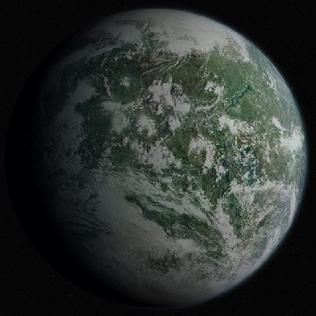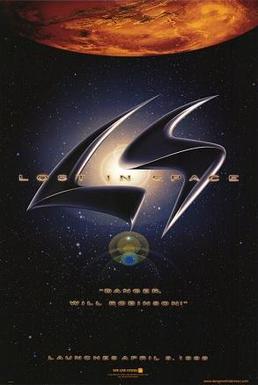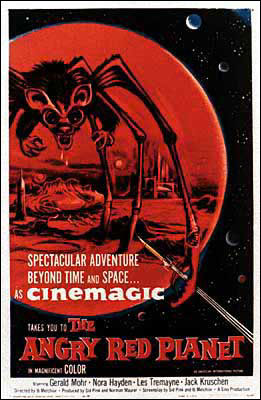Related Research Articles

Forbidden Planet is a 1956 American science fiction film from Metro-Goldwyn-Mayer, produced by Nicholas Nayfack, and directed by Fred M. Wilcox from a script by Cyril Hume that was based on an original film story by Allen Adler and Irving Block. It stars Walter Pidgeon, Anne Francis, and Leslie Nielsen. Shot in Eastmancolor and CinemaScope, it is considered one of the great science fiction films of the 1950s, a precursor of contemporary science fiction cinema. The characters and isolated setting have been compared to those in William Shakespeare's The Tempest, and the plot contains certain happenings analogous to the play, leading many to consider it a loose adaptation.

Dagobah is a fictional planet and eponymous star system appearing in the Star Wars films The Empire Strikes Back, Return of the Jedi, and Revenge of the Sith, and other media. It is depicted as a world of murky swamps, steaming bayous, and jungles, resembling Earth during the Carboniferous period. Dagobah is 14,410 kilometers in diameter with an orbital period of 341 days. Dagobah's climate and atmosphere consists of two seasons; a dry season, where the uplands become too hot for most life forms to survive; and a wet season, consisting of violent lightning storms, dense fog, and long periods of torrential rainfall. The Tash were a sentient species native to Dagobah.

Apocalyptic and post-apocalyptic fiction is a subgenre of science fiction in which the Earth's civilization is collapsing or has collapsed. The apocalypse event may be climatic, such as runaway climate change; astronomical, such as an impact event; destructive, such as nuclear holocaust or resource depletion; medical, such as a pandemic, whether natural or human-caused; end time, such as the Last Judgment, Second Coming or Ragnarök; or any other scenario in which the outcome is apocalyptic, such as a zombie apocalypse, cybernetic revolt, technological singularity, dysgenics or alien invasion.
Science fiction is a film genre that uses speculative, fictional science-based depictions of phenomena that are not fully accepted by mainstream science, such as extraterrestrial lifeforms, spacecraft, robots, cyborgs, mutants, interstellar travel, time travel, or other technologies. Science fiction films have often been used to focus on political or social issues, and to explore philosophical issues like the human condition.
"The Cage" is the first pilot episode of the American television series Star Trek. It was completed on January 22, 1965. The episode was written by Gene Roddenberry and directed by Robert Butler. It was rejected by NBC in February 1965, and the network ordered another pilot episode, which became "Where No Man Has Gone Before". Much of the original footage from "The Cage" was later incorporated into the season 1 two-part episode "The Menagerie" (1966); however, "The Cage" was first released to the public on VHS in 1986, with a special introduction by Gene Roddenberry, as a hybrid of the color footage that was used in "The Menagerie" and black and white footage which was not used in "The Menagerie". It was not broadcast on television in its complete all-color form until 1988. The black and white version and all-color version were also released in various standard-definition media including LaserDisc, VHS, and DVD formats.

Lost in Space is a 1998 American science-fiction adventure film directed by Stephen Hopkins, and starring William Hurt, Matt LeBlanc, Gary Oldman, and Heather Graham. The plot is adapted from the 1965–1968 CBS television series of the same name. Several actors from the TV show make cameo appearances.

The Angry Red Planet is a 1959 American science fiction film directed by Ib Melchior and starring Gerald Mohr.

It! The Terror from Beyond Space is an independently made 1958 American science fiction horror film, produced by Robert Kent, directed by Edward L. Cahn, that stars Marshall Thompson, Shawn Smith, and Kim Spalding. The film was distributed by United Artists as a double feature with Curse of the Faceless Man.

Subterranean fiction is a subgenre of adventure fiction, science fiction, or fantasy which focuses on fictional underground settings, sometimes at the center of the Earth or otherwise deep below the surface. The genre is based on, and has in turn influenced, the Hollow Earth theory. The earliest works in the genre were Enlightenment-era philosophical or allegorical works, in which the underground setting was often largely incidental. In the late 19th century, however, more pseudoscientific or proto-science-fictional motifs gained prevalence. Common themes have included a depiction of the underground world as more primitive than the surface, either culturally, technologically or biologically, or in some combination thereof. The former cases usually see the setting used as a venue for sword-and-sorcery fiction, while the latter often features cryptids or creatures extinct on the surface, such as dinosaurs or archaic humans. A less frequent theme has the underground world much more technologically advanced than the surface one, typically either as the refugium of a lost civilization, or as a secret base for space aliens.

The Green Slime is a 1968 tokusatsu science fiction film directed by Kinji Fukasaku and produced by Walter Manley and Ivan Reiner. It was written by William Finger, Tom Rowe and Charles Sinclair from a story by Reiner. The film was shot in Japan with a Japanese director and film crew, but with the non-Japanese cast of Robert Horton, Richard Jaeckel and Luciana Paluzzi.

Rainbow Brite and the Star Stealer is a 1985 American animated fantasy film directed by Bernard Deyriès and Kimio Yabuki. The film was produced by DIC Enterprises, Inc. and Hallmark Cards, and was released in the United States on November 15, 1985 by Warner Bros. It is the only film to feature the greeting card character Rainbow Brite; she also appeared in a few television specials prior to its release, and later in a Kideo TV series. In the film, Rainbow Brite tries to bring spring to an Earth that is already facing a perpetual winter. She must stop a wicked princess who wants all of Spectra, a planet-sized diamond through which all the light in the universe must pass.

Many works of fiction have featured UFOs. In most cases, as the fictional story progresses, the Earth is being invaded by hostile alien forces from outer space, usually from Mars, as depicted in early science fiction, or the people are being destroyed by alien forces, as depicted in the film Independence Day. Some fictional UFO encounters may be based on real UFO reports, such as Night Skies. Night Skies is based on the 1997 Phoenix UFO Incident.

Planet Earth is a 1974 American made-for-television science fiction film that was created by Gene Roddenberry, written by Roddenberry and Juanita Bartlett. It first aired on April 23, 1974 on the ABC network, and stars John Saxon as Dylan Hunt. It was presented as a pilot for what was hoped to be a new weekly television series. The pilot focused on gender relations from an early 1970s perspective. Dylan Hunt, confronted with a post-apocalyptic matriarchal society, muses, "Women's lib? Or women's lib gone mad..." The film also stars Diana Muldaur, Ted Cassidy, Janet Margolin, Christopher Cary, Corrine Camacho, and Majel Barrett. Marc Daniels directed the film.
A flag of Mars is a concept of a possible flag design, meant to symbolize the planet Mars or to represent a fictional Martian government, in works of fiction.
Invasion: Earth is a BBC science fiction TV series. It was made in collaboration with the Sci Fi Channel, and released in 1998 as six fifty-minute episodes.

"Saga of a Star World" is the pilot for the American science fiction television series Battlestar Galactica which was produced in 1978 by Glen A. Larson. A re-edit of the episode was released theatrically as Battlestar Galactica in Canada before the television series aired in the United States, in order to help recoup its high production costs. Later, the standalone film edit was also released in the United States.

Invasion of the Star Creatures is an independently made 1962 black-and-white science fiction/comedy film, produced by Samuel Z. Arkoff and Berj Hagopian, directed by Bruno VeSota, that stars Bob Ball and Frankie Ray. The film was theatrically released by American International Pictures as a double feature with The Brain That Wouldn't Die.

The Alpha Incident is a 1978 American science fiction horror film directed by Bill Rebane and starring Ralph Meeker, Stafford Morgan, John F. Goff, Carol Irene Newell, and George "Buck" Flower.

Strange World is a 2022 American animated science-fiction adventure film produced by Walt Disney Animation Studios and distributed by Walt Disney Studios Motion Pictures. It was directed by Don Hall, co-directed and written by Qui Nguyen, and produced by Roy Conli. The film stars the voices of Jake Gyllenhaal, Dennis Quaid, Jaboukie Young-White, Gabrielle Union, and Lucy Liu. Strange World follows a legendary family of explorers called the Clades, who must set aside their differences as they embark on a journey to a mysterious subterranean land inhabited by surreal lifeforms, in order to save a miracle plant Pando that is their society's source of energy.
References
- ↑ Stanley, J. (2000) Creature Feature : 3rd Edition
- ↑ "They (1974)". 26 April 2021.